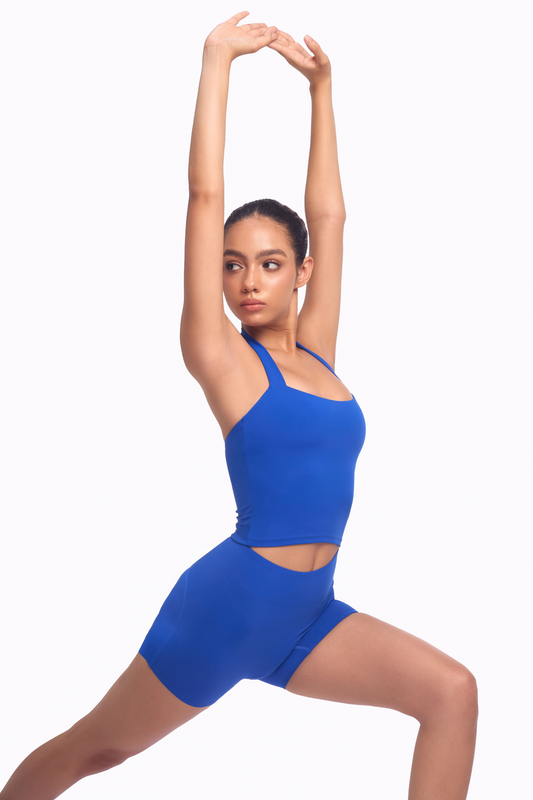When it comes to yoga, many people often imagine gentle, slow-paced exercises. However, Ashtanga Yoga opens up a completely different world – dynamic, powerful, and disciplined. In this article, Olaben will explore what Ashtanga Yoga is and highlight the key differences that make this method unique compared to other yoga styles. If you are looking for a practice that not only strengthens the body but also challenges the mind and focus, Ashtanga Yoga will surely provide valuable experiences.
What is Ashtanga Yoga?
Ashtanga Yoga is a form of Hatha Yoga originating from India, developed from the Vinyasa method. Its hallmark is the seamless combination of postures, breathing, and mental focus, helping practitioners harness and balance the body's inner energy.
Unlike some more flexible yoga styles, Ashtanga requires practitioners to perform postures in a specific sequence, demanding high discipline and precision.
The name “Ashtanga” comes from Sanskrit, where “Ashta” means eight and “Anga” means limb (arm or leg). Thus, Ashtanga Yoga is a system combining eight branches of yoga, forming a comprehensive practice method. These eight branches are not just physical techniques but also represent yoga’s deep philosophical foundation, including:
- Yamas – ethical guidelines
- Niyama – self-discipline
- Asana – body postures
- Pranayama – breathing techniques
- Pratyahara – withdrawal of the senses
- Dharana – concentration
- Dhyana – meditation
- Samadhi – enlightenment
By harmoniously combining body, breath, and mind, Ashtanga Yoga provides a comprehensive training path that not only improves physical health but also enhances focus and inner energy.

The Origin of Ashtanga Yoga
Ashtanga Yoga was developed by T. Krishnamacharya in the early 20th century as a personal practice method for his student K. Pattabhi Jois. Jois refined and later widely taught this method, introducing Ashtanga Yoga to the Western world in the 1970s.
The fast-paced sun salutation sequences in Ashtanga Yoga are believed to have been influenced by the exercises of Indian wrestlers and gymnasts of that era. These sequences not only detoxify the body but also promote mental calm and focus, forming the foundation for many modern yoga styles such as Hot Yoga, Flow Yoga, Vinyasa Yoga, and Power Yoga.
Today, the Ashtanga Yoga Research Institute in Mysore, India, is headed by R. Sharath Jois, the grandson of Pattabhi Jois. He is a senior authority on Ashtanga practice and promotes teaching and training of this method worldwide. Renowned Ashtanga Yoga instructors like David Swenson, Kino MacGregor, Richard Freeman, Maty Ezraty, Tim Miller, David Williams, Chuck Miller, and Tim Feldmann have helped bring Ashtanga Yoga to millions globally.

Benefits of Practicing Ashtanga Yoga
Ashtanga Yoga is a physically demanding form of yoga that also offers holistic health benefits for both body and mind, including:
- Calmer mood: The coordinated movements and breathing in Ashtanga enhance focus and calm the nervous system, helping regulate heart rate, respiration, and blood pressure for a more relaxed feeling (according to research by C.C. Streeter et al.).
- Improved mental health: A small 2017 study found that participants practicing Ashtanga twice a week for 9 consecutive weeks showed significant improvements in mental well-being and reduced symptoms of depression and anxiety.
- Muscle development: The full-body sequences strengthen muscles. A 2012 study on premenopausal women showed significant leg strength gains after practicing Ashtanga twice weekly compared to non-yoga participants.
- Promotes healthy eating habits: A 2009 study in the Journal of the American Dietetic Association indicated regular yoga practitioners tend to eat more balanced diets and make healthier food choices.
- Pain relief: According to a 2017 study by Robert B. Saper et al., participants practicing yoga once a week for 12 weeks experienced significant reductions in chronic back pain, comparable to physical therapy.
Thus, Ashtanga Yoga not only strengthens the body but also promotes mental balance, helping you live more energized and focused.

Principles of Practicing Ashtanga Yoga
Key principles help practitioners maximize both physical and mental benefits:
- Ujjayi Pranayama breathing: A special breathing technique used throughout practice. Slow inhalations create a soft ocean-like sound, warming the body, boosting energy, and increasing focus. Advanced pranayama techniques are taught only to experienced practitioners.
- Drishti (gaze point): Focus on a fixed point to maintain concentration and a meditative state during practice.
- Vinyasa transitions: Synchronizing breath with movement to create continuous sequences.
- Bandha (energy locks): Locking body energy to maintain stability and balance.
- Daily practice: Recommended 6 days/week, resting on Saturdays and during full/new moons. Women are advised to limit practice during menstruation.

Common Ashtanga Yoga Poses
Ashtanga Yoga is a continuous series of poses, coordinated with breath to build strength, flexibility, and concentration. Here are popular poses with detailed instructions:
1. Ujjayi Pranayama Meditation
Purpose: Warm up, focus the mind, prepare for subsequent poses.
Instructions:
- Sit comfortably with a straight spine.
- Inhale deeply through the nose, slightly constrict the throat to produce a gentle ocean-like sound.
- Exhale slowly while maintaining the throat constriction and sound.
- Repeat for 5–10 breaths, feeling the breath throughout the body.
Note: Ujjayi Pranayama warms the body, enhances focus, and regulates prana energy.
2. Butterfly Pose (Baddha Konasana)
Purpose: Increase hip flexibility, stretch inner thighs, and balance the body.
- Sit upright with legs extended forward.
- Bend knees, bring soles together, heels close to the hips.
- Open inner thighs, knees naturally lower toward the floor.
- Hold feet with hands, gently press knees down.
- Keep the spine straight, gaze downward, engage the core lightly.
- Hold for at least 5 deep breaths; optionally fold forward for deeper stretch.
Note: Do not force knees to the floor; allow the body to adjust gradually.
3. Wide-Leg Forward Fold (Prasarita Padottanasana)
Purpose: Lengthen the spine, stretch legs, hips, and back, improve flexibility.
- Stand straight with legs wide apart (shoulder-width or more).
- Step feet wider, place hands on hips.
- Exhale, hinge forward at the hips, keep spine straight.
- Place hands on the floor, shoulder-width apart, extend torso forward.
- Hold for 30–60 seconds, breathe deeply and evenly.
- Return slowly to standing.
Note: Maintain balance and controlled breathing; do not overreach.
4. Warrior Pose (Virabhadrasana)
Purpose: Strengthen legs and arms, improve balance.
- Stand straight with feet hip-width apart.
- Step right foot forward about 1 meter, rotate left foot 90°.
- Bend right knee until thigh is parallel to the floor, left leg straight.
- Raise arms overhead, relax shoulders.
- Hold for 30–60 seconds, breathe evenly, feel the stretch and stability.
- Return to standing and switch sides.
Note: Keep weight balanced, gaze forward, avoid leaning.
5. Extended Hand-to-Big-Toe Pose (Utthita Hasta Padangusthasana)
Purpose: Improve balance, strengthen legs, stretch hips and thighs.
- Stand straight, feet hip-width apart.
- Lift left leg, grasp big toe with left hand, right hand on hip.
- Extend leg straight, keep body upright and balanced.
- Hold for 30–60 seconds, breathe evenly.
- Lower leg slowly, return to standing, switch sides.
Note: If not flexible enough, slightly bend the knee and gradually extend as able.
6. Chair Pose (Utkatasana)
Purpose: Strengthen legs and core.
- Stand straight, feet hip-width apart.
- Bend knees, lower hips as if sitting, keep thighs parallel to floor.
- Raise arms overhead, relax shoulders, lightly engage core.
- Hold 30 seconds, breathe evenly.
- Exhale, straighten legs and return to standing.
Note: Distribute weight evenly on both feet, do not lean forward.
Tips for Practicing Ashtanga Yoga
- Embrace failure: Ashtanga is challenging; don’t get discouraged if it’s difficult at first.
- Start simple: Begin with sun salutations, then progress to more complex poses.
- Focus on breathing: The main benefit lies in your breath—prioritize it.
- Seek proper guidance: Find a qualified teacher to ensure correct technique and safety.
- Listen to your body: Notice changes in body and mind after each session.
- Stay consistent: Even 5 minutes daily counts, and reward yourself for milestones.

Enhance Your Yoga Practice with Olaben
To practice Ashtanga Yoga or any form of yoga effectively, having the right apparel and accessories is essential. Olaben offers products designed for comfort, flexibility, and confidence in every movement.
Women’s Yoga Apparel
Olaben’s women’s yoga clothing collection includes yoga leggings, crop tops, sports bras, and tops made from breathable, stretchy, sweat-absorbing fabrics, allowing easy movement, bending, and balancing without restriction.
Men’s Yoga Apparel
For men, men’s yoga apparel provides maximum comfort, made from lightweight, stretchy materials to support full-range Ashtanga Yoga movements.
Yoga Accessories
Olaben also offers quality accessories such as yoga mats, blocks, and straps to help maintain posture alignment and reduce injury risk.
Conclusion
Ashtanga Yoga is a challenging yet extremely rewarding practice. By integrating body, breath, and mind, it helps you strengthen muscles, improve flexibility, focus, and inner calm. With consistent practice, proper guidance, and suitable apparel from Olaben, your yoga journey will be more effective and enjoyable. Start today to experience the transformative power of Ashtanga Yoga.








